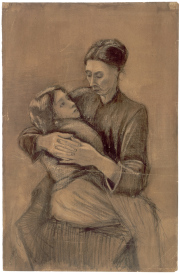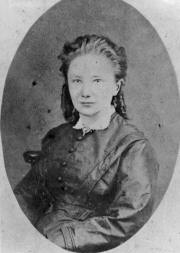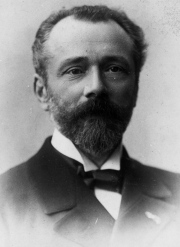4.1 Kept or thrown away
Theo was the great hoarder in the family, and it is thanks to his conscientious stewardship of letters, photographs, bills, account books and other documents, some of them mere scraps, that so much has survived. He kept huge piles of letters, from Jo Bonger, first his fiancée and then his wife,59 and from his relatives and family members, and later his mother returned letters that he and others had written to her. After his death in 1891 they remained in his estate thanks to Jo, their son Vincent Willem, and the Vincent van Gogh Foundation, and are now preserved in the Van Gogh Museum.
Although a lot has survived there are also glaring gaps. The family correspondence falls off dramatically after August 1879, and shortly afterwards dries up altogether. Now it could be that Theo did not keep his belongings in this period, or that they were lost, but it is by no means impossible that letters have deliberately been kept back. Jan Hulsker suspected that some had been destroyed because they would reveal too much about the conflict between the family and Vincent. In 1880, after all, his father wanted to have him committed to the mental asylum in Geel, Belgium.60 It is also possible that letters, or parts of letters from early 1883 have been lost, perhaps because of their intimate nature.61 This is reinforced by the fact that there are letters missing in which Vincent thanked Theo for money he had received. It is not known who was responsible for this censorship, if that is what it was, or when it was done. It was by no means uncommon for documents detailing conflicts to be thrown away in order to create a sanitized picture of a family for posterity.62
Vincent himself was decidedly careless with his mail. For example, the letters he received from his parents before 1877 suddenly came to light when they were discovered by chance in a reading-desk at the house of the Roos family in The Hague where he had been a lodger.63 They were then lost again, and it is a vain hope that these and several hundred other letters, particularly those from Theo to Vincent, will ever reappear.
Occasionally the question of whether to keep letters or not is raised by Vincent. ‘Have you saved my epistles? If you have a moment and they haven’t yet perished in the flames, read them again, I say, though perhaps it’s pretentious to ask such a thing of you. Still, I wrote them in earnest, though I didn’t hesitate to speak plainly and to give free rein to my imagination.’64
We have only 83 letters that were written to Van Gogh. Unlike Theo, he was not a hoarder, and he is known to have thrown or burned letters he received. The letters from Theo, Anna and Willemien and the one from Van Rappard are the only ones that still exist from before 1886, when he went to live with Theo in Paris. One from Gauguin was left behind in Paris.65 The remaining 77 letters all date from the last two years of Van Gogh’s life, and the bulk of them (65) were written after his first mental breakdown at the end of December 1888. Chance certainly played an important part in this, but it is nevertheless tempting to try and discover some logical pattern that would explain why some letters were kept and ended up in Theo’s possession, while others were not.66
Some of those that Van Gogh received in Provence have survived because he sent them on for Theo to read. That is what happened, for instance, with the one from Octave Maus and with 4 of the 16 letters from Gauguin.67 The first one he got from Gauguin in Arles escaped oblivion through absent-mindedness, for he wrote to Theo that he thought he had burned it but had now found it again and sent it for him to read.68 It is understandable that he did not think it worth keeping this rather businesslike letter. He was more careful with later ones from Gauguin dealing with artistic matters. Some he sent to Theo, and there are a few containing sketches and descriptions of works of art.
There are clear indications that at a certain point Vincent decided to keep the letters from Theo and Jo, for they have survived almost in their entirety from the end of April 1889 on. That could also be because other people packed up his belongings or cleared up after him and gave or sent them to Theo (such as Joseph Roulin, who cleared up the Yellow House after the ear episode, and the doctor Théophile Peyron, who sent things on from the asylum in Saint-Rémy).69 It is odd that the letters from Theo and Jo were preserved while those from Willemien and Mrs Van Gogh are missing, but one possible explanation is that Theo gave these back to them after Vincent’s death.
It is difficult to come up with a reason why the other letters to Van Gogh have survived. He could have kept the one from Signac because of the invitation to come and visit him, and he would have kept others apart because they contained the sender’s address (like the calling card from Salles and the letters from Milliet and Mourier-Petersen). It stands to reason that Van Gogh found the letters from Gauguin important and interesting enough to keep, but then why don’t we have all of them? And why have those from Bernard vanished? Although Vincent told Theo in September 1888 that he was keeping them and that they were ‘quite a bundle’ (682), they are nevertheless lost. That is a pity, because there were a lot of sketches in them, and it would be fascinating to follow the discussion between the two artists from both sides.
4.2 Lost correspondence
In addition to the 903 extant letters there must have been a considerable number from and to Van Gogh that we no longer have. This can be deduced from remarks like ‘Thank you for your letter’, ‘I received a letter from’, ‘I’ve written to’ and so on. In the surviving correspondence of other members of the family – particularly letters received by Theo – there are also references to letters from and to Vincent. An inventory of those statements shows that in addition to the existing corpus there must have been around 290 other letters that he wrote, and some 550 that he received. This brings the total of known and ‘virtual’ letters to around 1,750.70 It is quite impossible to say how many others have disappeared without leaving any demonstrable trace of their existence.
The letters to Theo contain numerous references to letters from him to Vincent that are no longer extant (they have been included in the above totals), but there were undoubtedly more. Additionally, Theo’s regular remittances of money must almost always have been accompanied by a letter, even if Vincent merely confirmed receipt of the money and made no reference to the letter. As against the 57 letters from Van Gogh to Anthon van Rappard there is just a single reply from the latter (letter 503). The correspondence with Gauguin must have amounted to more than what we now have, and all the letters from Emile Bernard to Van Gogh have to be considered lost. There must have been a few dozen of them, as well as a similar number from Van Gogh’s sister Willemien.
It can be assumed that by far the majority of the lost letters dated from early in Van Gogh’s life, for it would only have been natural for him to start writing regularly to members of the family and other relatives, however dutifully, when he left the parental home in the summer of 1869, and for him to continue doing so until around 1875, when he gradually began paying less heed to the norms and etiquette with which he had been brought up. We also know that he corresponded with the Gladwells, father and son, Uncle Hein and Uncle Jan, his teacher Mendes da Costa, his cousin Kee Vos and her father J.P.S. Stricker when he was courting her in the autumn of 1881, and with his girlfriends Sien Hoornik and Margot Begemann, but nothing of this has survived.71 Just as Van Gogh cleared up by burning letters or throwing them away, so many of the letters that he himself wrote to others have been destroyed in the course of time.

Woman with a child on her lap (Sien with her daughter Maria), 1883 (F 1067 / JH 356), Amsterdam, Van Gogh Museum / Vincent van Gogh Foundation
That was the case, for instance, with the correspondence with Margot Begemann. She was the Van Goghs’ neighbour in Nuenen with whom Vincent started an affair in 1884. He considered marrying her, but both families were dead set against it. The drama reached its pitch with Margot’s attempted suicide, according to Van Gogh because people spoke badly of them (he gives a vivid account of the events in letter 456 to Theo). The Reverend Van Gogh informed Theo shortly afterwards: ‘It’s said that the relationship has been broken off, but the friendship will continue. They still correspond constantly’.72 Van Gogh visited her a few times in Utrecht, where her family had sent her to live with a doctor friend, and their correspondence dated from that period. Margot’s niece, Sientje Begemann, later recalled that ‘Aunt Go had lots of letters from Vincent. She burned them all. It was forbidden to utter the name Vincent in the Begemann household’.73

Margot Begemann, (Amsterdam, Van Gogh Museum / Documentation)
The letters that Van Gogh wrote to H.G. Tersteeg, his and later Theo’s boss in the Goupil gallery in The Hague, also ended up on the fire. The successful Tersteeg was a model for the brothers, and when Vincent decided to become an artist his former employer was a connection in the art world of whom he had high hopes. Tersteeg was amenable at first, but he too turned his back on Van Gogh when he started living with Sien. Vincent was constantly railing against Tersteeg in his letters to Theo from that period, and the many pages that he devotes to ‘H.G.T.’ show that he found it very difficult to be rejected by the man who, according to Theo, had been ‘almost like an elder brother’ to them.74 The breach was never repaired, although later in Arles Van Gogh did try, through Theo, to interest Tersteeg in the art of the Impressionists, and wanted to give him a painting.75

H.G. Tersteeg, c. 1885 (Amsterdam, Van Gogh Museum / Documentation)
Van Gogh’s sister Elisabeth later recalled that Tersteeg had ‘a chiffonier with drawers full of letters from Vincent’.76 According to Tersteeg’s son Johan, those ‘two or three hundred letters’ were thrown into the stove one day: ‘my father did not consider all that writing so important – don’t talk artist, paint!’ Van Gogh’s letters were not the only ones that Tersteeg burned, ‘letters by masters of the Hague School also went into the fire from time to time’, according to his son.77 Only one letter from Van Gogh, which Tersteeg’s wife had given away, resurfaced a few years ago. Dated 3 August 1877, it is a letter of condolence on the death of Tersteeg’s newborn daughter. Convention dictated a restrained, short letter, but Van Gogh, an aspiring student of theology and obsessed with religion, took several liberties. The letter was very long and peppered with quotations from the Bible, Van Gogh inserted new text between the lines, wrote about himself in order to create a good impression, and signed off with a cheery ‘Yours truly’ (in English), and even went so far as to ask Tersteeg to pass on an enclosed letter to Theo. All the same, his compassion is palpable, and he made things easier for Tersteeg by going over several letters in his spidery handwriting to make them more legible.78
Then there is the case of the supposed correspondence between Van Gogh and the Hague factory owner Lodewijk Cornelis Enthoven. According to members of his family he supported Van Gogh financially in his Hague period, and later received an ‘endless stream of laments, ... all of them accompanied by small sketches and scratches’ from Nuenen and Antwerp. Van Gogh is said to have written to him from France and to have sent him rolls of paintings and sketches, but after Enthoven’s death they were found unopened in the attic and burned by his children.79 However, there is no mention at all of this correspondence with Enthoven in Van Gogh’s letters, and there is no tangible evidence to support these assertions.
A lot of Van Gogh’s correspondence with other artists has also been lost. We only have three letters from him to the Australian painter John Peter Russell, but there must have been at least five more.80 Arnold Koning also had more than the two that are now known. In 1912 he wrote to Albert Plasschaert: ‘He never stopped talking about his work and his ideas on colour, about which I will send you a couple of letters from that period for your perusal. I had some more, but they have disappeared as a result of numerous moves’.81
Unfortunately, nothing has survived of the exchange of letters between Van Gogh and the Hague School artist Anton Mauve, who was his cousin by marriage. In 1881 Mauve helped him as he took his first steps on the path to becoming a painter, and Van Gogh greatly admired him at the time. ‘Mauve gave me encouragement recently when I needed it. He’s a man of genius’ (176). He continued to be a guiding light for Van Gogh until they had a quarrel in the spring of 1882 and Mauve broke off all contact with him, and once again it was because of Van Gogh’s bad behaviour, his ‘vicious character’ (in Mauve’s words), and his relationship with Sien.82 That Van Gogh nevertheless continued to value his teacher as an artist is clear from the many times he mentions him in the letters. He was deeply affected by the news of Mauve’s death at the end of March 1888, and decided to dedicate his painting Pink peach trees (F 394 / JH 1379) to him and asked for it to be given it to his widow.83
Shortly after arriving in Arles Van Gogh wrote not only to Bernard but to another artist friend in Paris, Henri de Toulouse-Lautrec, for he had ‘solemnly promised to write’ to both of them (588).84 They must have regularly spent time together in Paris, but Toulouse-Lautrec evidently did not reply, and Van Gogh never wrote to him again, as far as we know. Toulouse-Lautrec’s published correspondence shows that he was not the fervent letter-writer that Van Gogh was. For him, letters were mainly a way of staying in touch with his family and making business appointments, and not for sharing his ideas about life and art or going into deep discussions about artistic matters.85 Theo told the friends about each other’s work, and during Vincent’s last visit to Paris on 6 July 1890 Toulouse-Lautrec dropped by to see him. Jo recalled that the pair of them ‘had the biggest laugh ... about an undertaker’s assistant, whom they met on the stairs’.86 A few weeks later, Toulouse-Lautrec wrote to Theo on the occasion of Vincent’s death: ‘You know what a friend he was to me and how eager he was to demonstrate his affection’.87
A very small number of letters, eleven in all, can be described as business correspondence.88 Most of those in this category are now lost, such as the ones that Van Gogh wrote in 1878 to the clergymen Nicolaas de Jonge, Abraham van der Waeyen Pieterszen and Emile Rochedieu in order to be admitted as a trainee evangelist in Laeken in Belgium,89 and the ‘rather long and consequently impractical’ letter that he sent to Theo in April 1885 for the Paris art dealer Alphonse Portier. He wrote to the painter Charles-Emmanuel Serret with the same purpose, to draw attention to his Potato eaters.90 In the summer of 1885 he corresponded with the Hague paint merchant Willem Leurs, who had paintings of his on commission. None of these letters have survived. There is one surviving letter to Hendrik Jan Furnée (523), and one crossed-out order for paints (RM13), but the rest of the correspondence is lost.91
From Arles Van Gogh wrote to Guillaume Tasset of the Paris suppliers of artists’ materials Tasset & Lhôte in order to explain an order for paints, and on one occasion in Saint-Rémy he ordered canvas from him, as he told Theo (these letters to Tasset no longer exist). These were exceptions, because it was usually Theo who placed the orders with Tasset. Vincent also received invitations through Theo to exhibit. In addition to Octave Maus of Les Vingt, Edouard Dujardin approached him on behalf of the Revue Indépendante. The letters from and to Maus have been preserved, but the one from Dujardin and Van Gogh’s refusal have not.92
On the basis of all these facts, clues and assumptions, we estimate that Van Gogh’s total correspondence may have run to more than 2,000 letters.